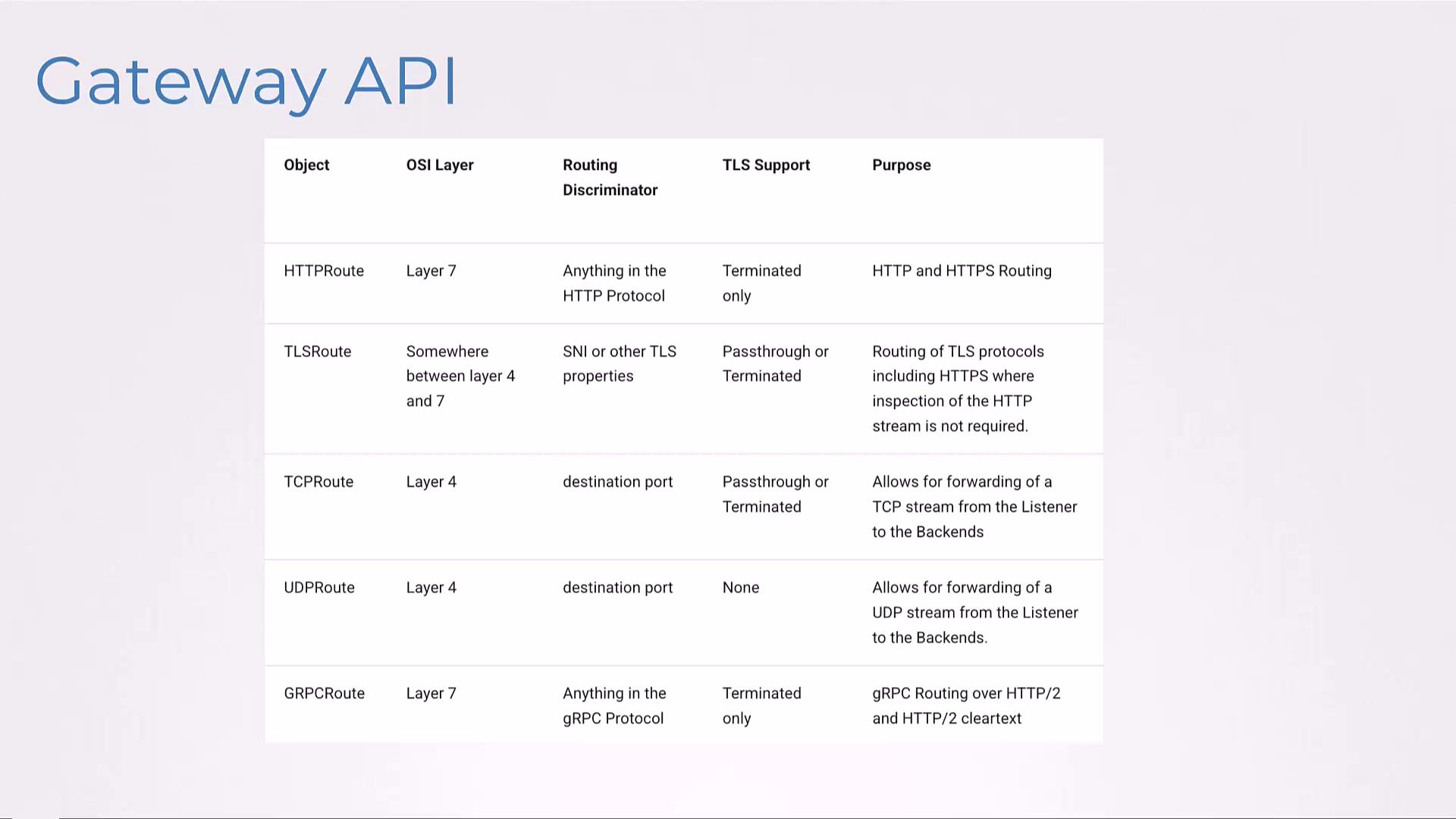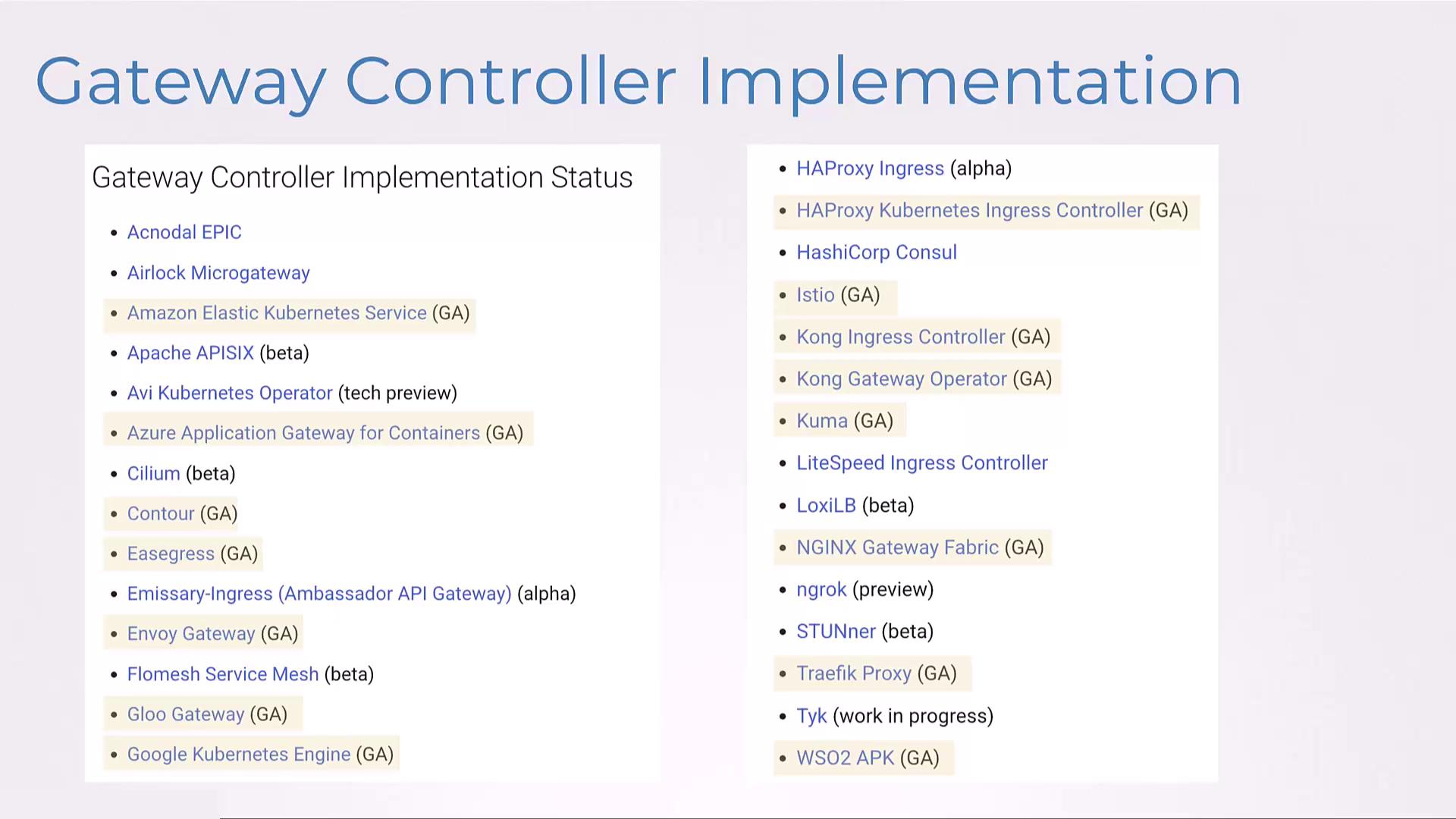CKA Certification Course - Certified Kubernetes Administrator
Networking
Introduction to Gateway API 2025 Updates
In this article, we introduce the Gateway API and explain how it addresses the challenges posed by the traditional Ingress resource. Previously, when using Ingress, multiple teams or organizations sharing a single Ingress resource faced coordination challenges. For instance, if team A manages a web service and team B manages a video service, they would need to coordinate their changes on one Ingress resource. This multi-tenancy issue is a significant limitation of Ingress, which can only be managed by one team at a time.
Limitations of Ingress
Consider the basic Ingress configuration below, which routes traffic based on host names:
# ingress-wear-watch.yaml
apiVersion: extensions/v1beta1
kind: Ingress
metadata:
name: ingress-wear-watch
spec:
rules:
- host: wear.my-online-store.com
http:
paths:
- backend:
serviceName: wear-service
servicePort: 80
- host: watch.my-online-store.com
http:
paths:
- backend:
serviceName: watch-service
servicePort: 80
This configuration supports HTTP-based rules such as host and path matching. However, it does not natively support other routing protocols like TCP, UDP, or advanced features such as traffic splitting, header manipulation, authentication, or rate limiting. To implement these capabilities, controller-specific annotations are used. For example, the following configuration adds NGINX-specific SSL redirection via annotations:
# ingress-with-annotations.yaml
apiVersion: extensions/v1beta1
kind: Ingress
metadata:
name: ingress-wear-watch
annotations:
nginx.ingress.kubernetes.io/ssl-redirect: "true"
nginx.ingress.kubernetes.io/force-ssl-redirect: "true"
spec:
rules:
- host: wear.my-online-store.com
http:
paths:
- path: /foo
backend:
serviceName: wear-service
servicePort: 80
- host: watch.my-online-store.com
http:
paths:
- backend:
serviceName: watch-service
servicePort: 80
Note
Because each controller implements its own set of annotations, these configurations are tightly coupled to specific controllers and cannot be validated by Kubernetes itself.
Similarly, advanced scenarios like configuring Cross-Origin Resource Sharing (CORS) require different annotations depending on the controller. For example, a CORS configuration for NGINX might look like this:
# Ingress-cors.yaml (for NGINX)
apiVersion: networking.k8s.io/v1
kind: Ingress
metadata:
name: cors-ingress
annotations:
nginx.ingress.kubernetes.io/enable-cors: "true"
nginx.ingress.kubernetes.io/cors-allow-methods: "GET, PUT, POST"
nginx.ingress.kubernetes.io/cors-allow-origin: "https://allowed-origin.com"
nginx.ingress.kubernetes.io/cors-allow-credentials: "true"
And for a traffic controller like Traefik, a similar configuration would be:
# Ingress-traefik.yaml
apiVersion: networking.k8s.io/v1
kind: Ingress
metadata:
name: traefik-ingress
annotations:
# CORS Configuration
traefik.ingress.kubernetes.io/headers.customresponseheaders: |
Access-Control-Allow-Origin: '*'
Access-Control-Allow-Methods: GET, POST, PUT, DELETE, OPTIONS
Access-Control-Allow-Headers: Content-Type,Authorization
Access-Control-Allow-Credentials: true
Access-Control-Max-Age: 3600
These examples clearly demonstrate that the same use case leads to different configurations based solely on the chosen controller.
Introducing the Gateway API
The Gateway API was created as an official Kubernetes project to overcome the limitations of Ingress. It supports both layer 4 (transport) and layer 7 (application) routing, representing the next generation of load balancing and service mesh APIs. By decoupling responsibilities, the Gateway API introduces three distinct objects:
- Gateway Class: Configured by infrastructure providers to define the underlying network infrastructure (e.g., NGINX, Traefik, or other load balancers).
- Gateway: Managed by cluster operators; these are instances built from a Gateway Class.
- HTTPRoute (and other route types): Managed by application developers; these routes support various protocols such as HTTP, TCP, and gRPC.
Unlike Ingress, the Gateway API offers a unified and declarative configuration that is independent of controller-specific annotations.
Gateway API Configuration Example
The following example illustrates how to define a Gateway Class, a Gateway, and an HTTPRoute using the Gateway API:
# gateway-class.yaml
apiVersion: gateway.networking.k8s.io/v1
kind: GatewayClass
metadata:
name: example-class
spec:
controllerName: example.com/gateway-controller
# gateway.yaml
apiVersion: gateway.networking.k8s.io/v1
kind: Gateway
metadata:
name: example-gateway
spec:
gatewayClassName: example-class
listeners:
- name: http
protocol: HTTP
port: 80
# http-route.yaml
apiVersion: gateway.networking.k8s.io/v1
kind: HTTPRoute
metadata:
name: example-httproute
spec:
parentRefs:
- name: example-gateway
hostnames:
- "www.example.com"
rules:
- matches:
- path:
type: PathPrefix
value: /login
backendRefs:
- name: example-svc
port: 8080
In this configuration, the HTTPRoute routes requests with a path prefix of "/login" arriving at "www.example.com" to the backend service "example-svc" on port 8080.
TLS Configuration with Gateway API
Traditional Ingress configurations handle TLS by using the spec.tls section, often accompanied by additional annotations to enforce HTTPS redirection. Consider the following Ingress example for a secure application:
# ingress-secure-app.yaml
apiVersion: networking.k8s.io/v1
kind: Ingress
metadata:
name: secure-app
annotations:
nginx.ingress.kubernetes.io/ssl-redirect: "true"
nginx.ingress.kubernetes.io/force-ssl-redirect: "true"
spec:
tls:
- hosts:
- secure.example.com
secretName: tls-secret
In contrast, the Gateway API allows for a more structured TLS configuration as part of the listener definition:
# gateway-secure.yaml
apiVersion: gateway.networking.k8s.io/v1
kind: Gateway
metadata:
name: secure-gateway
spec:
gatewayClassName: example-gc
listeners:
- name: https
port: 443
protocol: HTTPS
tls:
mode: Terminate
certificateRefs:
- kind: Secret
name: tls-secret
allowedRoutes:
kinds:
- kind: HTTPRoute
Here, the HTTPS listener on port 443 is explicitly configured with TLS termination, referencing the necessary TLS secret. The allowedRoutes field ensures that only HTTPRoute objects can attach to the listener.
Traffic Splitting and Canary Deployments
Ingress relies on annotations for complex use cases like canary deployments. For example, you might use NGINX annotations to route 20% of the traffic to a new application version:
# canary-ingress.yaml
apiVersion: networking.k8s.io/v1
kind: Ingress
metadata:
name: canary-ingress
annotations:
nginx.ingress.kubernetes.io/canary: "true"
nginx.ingress.kubernetes.io/canary-weight: "20"
spec:
rules:
- http:
paths:
- path: /
pathType: Prefix
backend:
service:
name: app-v2
port:
number: 80
The Gateway API simplifies this process by natively defining traffic splitting within an HTTPRoute:
# app-gateway.yaml
apiVersion: gateway.networking.k8s.io/v1
kind: HTTPRoute
metadata:
name: split-traffic
spec:
parentRefs:
- name: app-gateway
rules:
- backendRefs:
- name: app-v1
port: 80
weight: 80
- name: app-v2
port: 80
weight: 20
In this example, "app-v1" receives 80% of the traffic while "app-v2" handles the remaining 20%. This declarative and controller-agnostic approach greatly simplifies advanced traffic management scenarios.
Centralized Advanced Configuration
For features like Cross-Origin Resource Sharing (CORS), the Gateway API centralizes configurations without relying on controller-specific annotations. Consider the following Gateway API-based CORS configuration:
# http-route-cors.yaml
apiVersion: gateway.networking.k8s.io/v1
kind: HTTPRoute
metadata:
name: cors-route
spec:
parentRefs:
- name: my-gateway
rules:
- matches:
- path:
type: PathPrefix
value: /api
filters:
- type: ResponseHeaderModifier
responseHeaderModifier:
add:
- name: Access-Control-Allow-Origin
value: "*"
- name: Access-Control-Allow-Methods
value: "GET, POST, PUT, DELETE, OPTIONS"
- name: Access-Control-Allow-Headers
value: "Content-Type,Authorization"
- name: Access-Control-Allow-Credentials
value: "true"
- name: Access-Control-Max-Age
value: "3600"
backendRefs:
- name: api-service
This self-contained configuration is consistent and works seamlessly across different Gateway API controllers.
Gateway API Controller Support
A range of major controllers now support, or are actively implementing, the Gateway API. This industry support includes platforms such as Amazon EKS, Azure Application Gateway for Containers, Contour, Envoy, Google Kubernetes Engine, HAProxy, Istio, Kong, Kuma, NGINX, and many others. Such broad adoption underlines the growing momentum and reliability of the Gateway API.


Conclusion
The Gateway API overcomes the limitations of Ingress by providing a more declarative, structured, and multi-protocol solution for traffic management. By segregating responsibilities among GatewayClass, Gateway, and HTTPRoute, it simplifies multi-tenant management and advanced routing scenarios such as TLS termination, traffic splitting, and CORS configuration.
Tip
For a deeper understanding of these concepts, try practicing with hands-on labs to experiment with different Gateway API configurations.
Watch Video
Watch video content